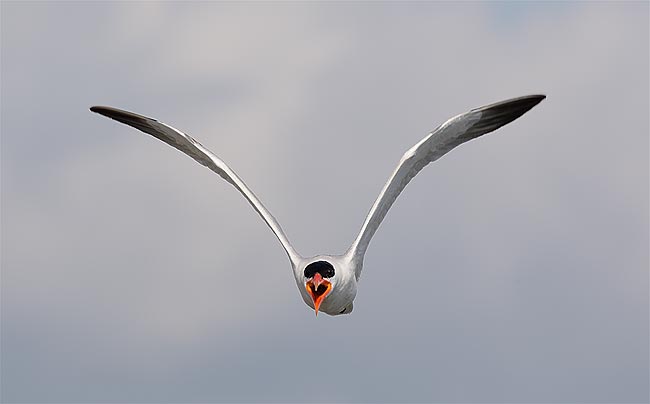
BIRDS AS ART BULLETIN 236
July 15, 2007
Visit: www.birdsasart.com
ROBERT O’TOOLE ON THE MARK III
SUMMER FUN IN FLORIDA WITH FROGGIE
ABP vs ABP II VS DB
MORE MARK III TIPS & MIII UG COMMENTS
ROBERT O’TOOLE’S CORRUPTION PREVENTION AND IMAGE RESCUE TIP
JUNE 2008 BEAR BOAT TRIP LED BY ROBERT O’TOOLE
Contact us by phone at 863-692-0906 (Eastern Time Zone) or by e-mail at birdsasart@att.net or birdsasart@verizon.net. The att e-mail address is best from overseas.
We gladly accept credit card orders by phone 8am till 9pm Eastern Time (8 am till 3pm Fridays).
You can use the Paypal links on the web site to order anything. Just type in the item(s) and the amount. If using your own Paypal account, please send to either of the e-mail addresses above.
Note: maximize this e-mail for best formatting.
Photographic theme: images made on James Shadle’s flats boat/712 & 13.
Important Request: if responding to this e-mail, please take the time to delete all images and all irrelevant text.

Caspian Tern on attack run… Tampa Bay, FL with James Shadle
Image Copyright 2007: Arthur Morris/BIRDS AS ART
Canon EF 400mm f/4L DO lens with the EOS-1D Mark III. ISO 400. Evaluative metering +2/3 stop: 1/1600 sec. at f/8 in Manual mode.
For birds flying directly at me I am now setting C.Fn. III-2 to High and using 45-point. See more details below in MORE MARK III TIPS & MIII UG COMMENTS. After repeatedly borrowing the 400 DO lens from CPS, I finally broke down and purchased my very own.
ROBERT O’TOOLE ON THE MARK III
While photographing on James Shadle’s boat for the last 2 days I had the opportunity to use each of Artie’s three EOS-1D Mark III camera bodies. I created about 2000 images; thanks a million Artie! Having given up 2 waiting list spots to good friends of mine in June I have had only had limited chances to use the EOS-1D Mark III since February. Aside from the easy changes like back button ( * ) AF, slow tracking, and 45 point AF the 5 different Mark III cameras that I have used have not been set up with my personal preferences. So far I have found that the AF system works great. I wouldn’t say the AF system is an improvement over the s EOS-1D Mark II N but I haven’t had any problems at all with the AF either. I would expect that with additonal time in the field and a personally- tuned EOS-1D Mark III that the AF system would be deadly. I am aware of the AF issues reported by many people including a few friends of mine. Though I might be flamed for voicing my opinions here I am just reporting honestly on experiences; your mileage may vary. I was able to look back at images made over the past year or so with my 1DSMKII and 1DMKIIN since I save copies of folders with intact deletes. I have found that the AF success rates with the MIII are similar to success rates with the other professional digital camera bodies (none of which are 100% on target). (AM note: Robert is far more skilled than I as a flight photographer and his percentage of sharp images are much higher than mine with whatever camera he is using—even mine…) My 1DSMKII in fact may have the best AF success ratio of all.
For the record, I have been using Canon EOS since 1992 and EOS Digital SLRs since my D30 which I purchased for $3400, in 2000. I purchased my first Canon EOS-1D body for $5400 in 2001. I was able to get a $100 discount on my second 1D ! I have been photographing professionally since 2001 and have owned 1DS, 1DMKII, 1DSMKII, and 1DMKIIN pro bodies. Taking these factors into account I probably have more years using Canon 1D series bodies than most people.
Below is a selection of recent images…
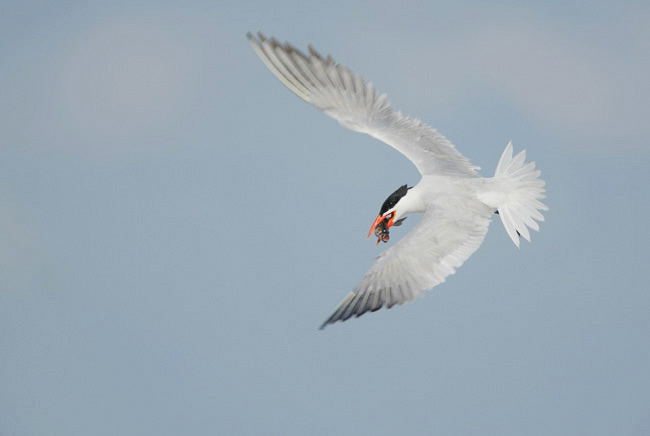
Caspian Tern with prey (gasping), Tampa Bay, FL with James Shadle
Image Copyright 2007: Robert O’Toole
Canon EF600mm f/4L USM lens with the 1.4X II TC and the EOS-1D Mark III. ISO 200. Evaluative metering +2/3 stop: 1/1000 sec. at f/5.6 in Manual mode.
Terns in flight have always been a favorite of mine. Here I captured a parent pausing for a split second before diving almost straight down to the colony to feed its chick. All the images were made with 45 point AF. Since November 2005 I have been using 45 point AF almost exclusively.
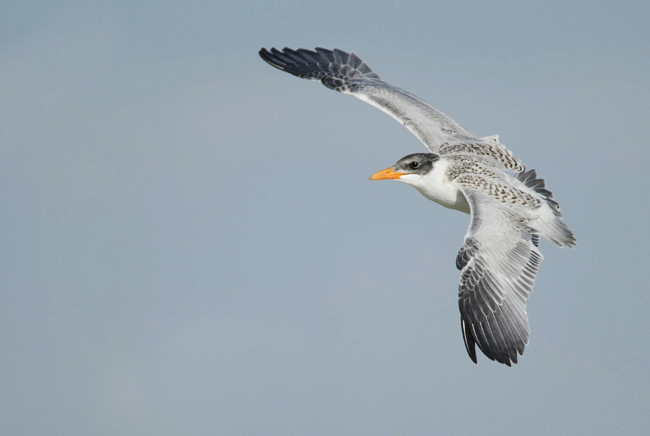
Caspian Tern juvenile turning in flight, Tampa Bay, FL with James Shadle
Image Copyright 2007: Robert O’Toole
Canon EF600mm f/4L USM lens with the 1.4X II TC and the EOS-1D Mark III. ISO 200. Evaluative metering +2/3 stop: 1/1250 sec. at f/5.6 in Manual mode.
Caspian tern juveniles are absolutely gorgeous. I was constantly on the look out for the juveniles practicing takeoffs and landings. Here I was lucky to get one banking over the colony.
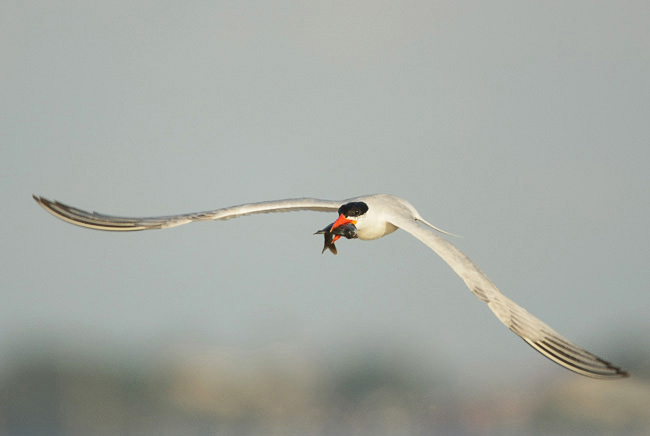
Caspian Tern with catch, Tampa Bay, FL with James Shadle
Image Copyright 2007: Robert O’toole
Canon EF600mm f/4L USM lens with the 1.4X II TC and the EOS-1D Mark III. ISO 320. Evaluative metering +2/3 stop: 1/1000 sec. at f/5.6 in Manual mode.
To maximize success with a high frame rate capable camera it is important to use restraint and wait for the subject to fill the frame before releasing the shutter. Here I waited until I could see details in the birds face, but not too late as to clip the wings.
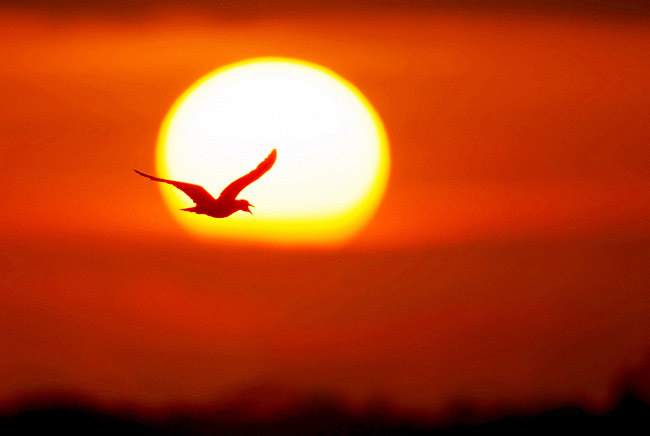
Caspian Tern with sun disk, Tampa Bay, FL with James Shadle
Image Copyright 2007: Robert O’toole
Canon EF600mm f/4L USM lens with the 1.4X II TC and the EOS-1D Mark III. ISO 200. Evaluative metering: 1/1250 sec. at f/5.6 in Manual mode.
It was a blessing to have a hazy sun disk on Friday morning with so many terns in the air. The technique is simple; the MKIII frame rate and deep buffer are great assets when trying to create images like this. Meter the sun, set your exposure manually, lock onto a bird as it flies by at the same height as the sun and pan. When you see the bright orange near the disk-edge, hold the shutter button down until the bird is past the sun.
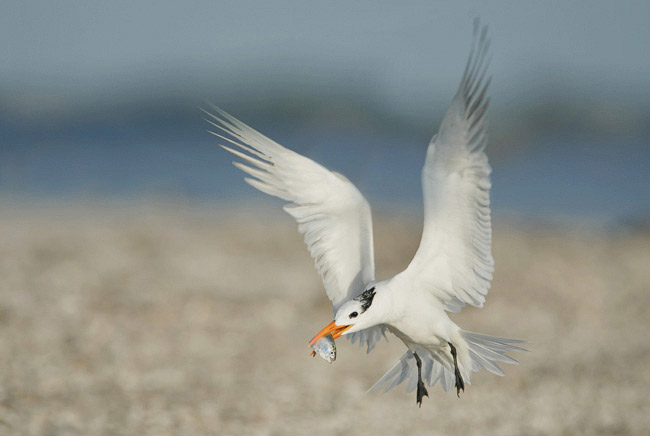
Royal Tern with fish for large chick, Tampa Bay, FL with James Shadle
Image Copyright 2007: Robert O’toole
Canon EF600mm f/4L USM lens with the 1.4X II TC and the EOS-1D Mark III. ISO 200. Evaluative metering +2/3 stop: 1/800 sec. at f/5.6 in Manual mode.
As I made this image I could see the fish wriggling and fighting to escape. All in all we had three great sessions.
SUMMER FUN IN FLORIDA WITH FROGGIE
When folks ask me about photographing in Florida during the summer months I run out of suggestions after mentioning Fort DeSoto (http://www.birdsasart.com/siteguides.htm#the%20Fort%20DeSoto/Sarasota%20Site-Guide). When I headed out to Tampa Bay this past Thursday and Friday I really had my eyes opened. I got to photograph Caspian Terns in flight, juvenile Caspian Terns, Royal Terns and Laughing Gulls in flight and feeding young, recently fledged Little Blue Herons, Reddish Egrets, White Ibises, and Brown Pelicans. And I got my head portraits of baby Roseate Spoonbills. There was so much to photograph that at times you simply could not decide where to point your lens. You can see a selection of my images below.
There are about two weeks left
in the baby bird season on Tampa Bay. If you would like to join Jim for a full
or half-day, you can contact him
as follows: by cell phone at 813-363-2854 or via e-mail at
James@wildflorida.net.
We have been somewhat remiss in failing to mention previously that most of the photography on a boat trip with Froggie is done from out of the boat. (Some folks have shown up with their Sunday-best Air Jordans…
Immediately below is a selection of James Shadle’s images from our three half-days on the boat. (If you have any Nikon-related questions or are curious as to exposure system, please e-mail James at james@wildflorida.net and copy me. Thanks!)
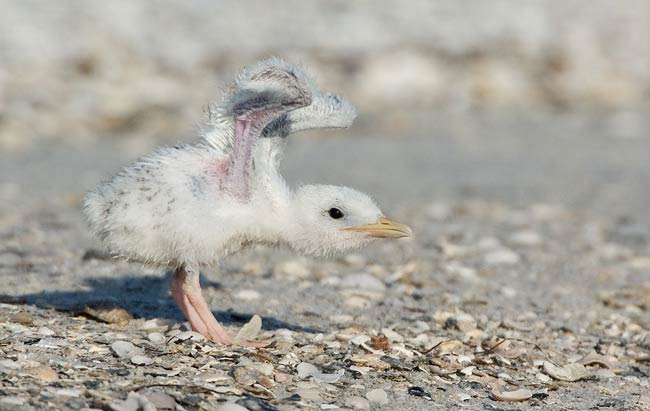
Royal Tern, baby’s wing stretch, Tampa Bay, FL
Image Copyright 2007: James Shadle
Nikon 600mm F4 ED AF-S lens with TC14E and the Nikon D2X. ISO 400. Exposure Based on a value of 2/3 of a stop less than Sunny 16 - 1/3 stop: 1/2000 sec. at f/8.0 in Manual Mode.
As a great bird photographer once said, "You gotta love it!"
To capture an image like this requires being there and being prepared. If you know your exposure value and camera controls, nailing the decisive moment becomes a little less difficult.
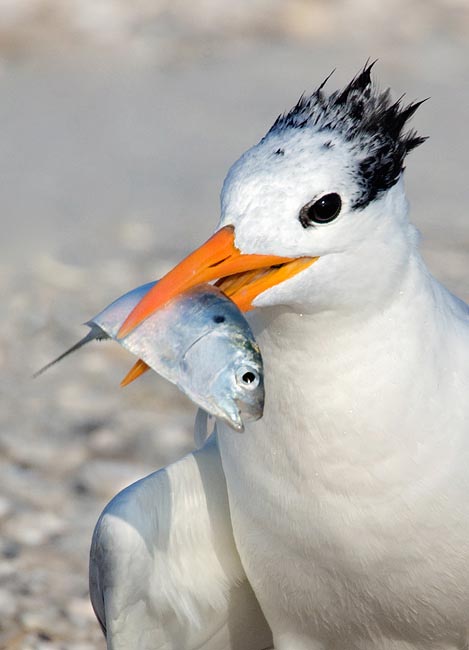
Royal Tern with Gulf Menhaden, Tampa Bay, FL
Image Copyright 2007: James Shadle
Nikon 600mm F4 ED AF-S lens with TC14E and the Nikon D2X. ISO 400. Exposure Based on a value of 2/3 of a stop less than Sunny 16 - 1/3 stop: 1/400 sec. at f/14 in Manual Mode.
Knowing my subject allowed me to get my TC14E on in time to capture this tight shot of a Royal Tern preparing to feed a baby.
Tip: listen to the Terns. Those making the most noise while flying about are trying to locate their chicks and almost always have a fish.
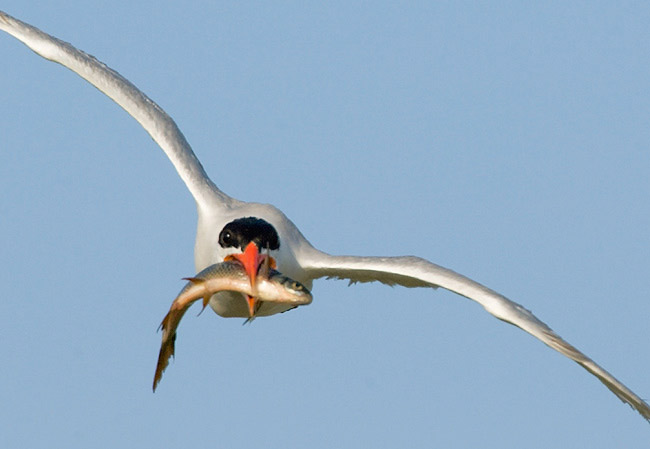
Caspian Tern with Mullet, Tampa Bay, FL
Image Copyright 2007: James Shadle
Nikon 600mm F4 ED AF-S lens with TC14E and the Nikon D2X. ISO 400. Exposure based on a value of 2/3 of a stop less than Sunny 16 - 1/3 stop 1/1600 sec. at f/9.0 in Manual Mode
Predictable, repeatable behavior; I love it! If you know your subject making this type of image can be come routine.
Due to the speed, direction and size of my subject I chose these AF settings on my D2X:
Single Area Dynamic AF, AF-C , Frame Speed /Focus Balance, Lock -On set to Short, AF On with Shutter Button
Exposure is based on a value of 2/3 a stop less than sunny 21.
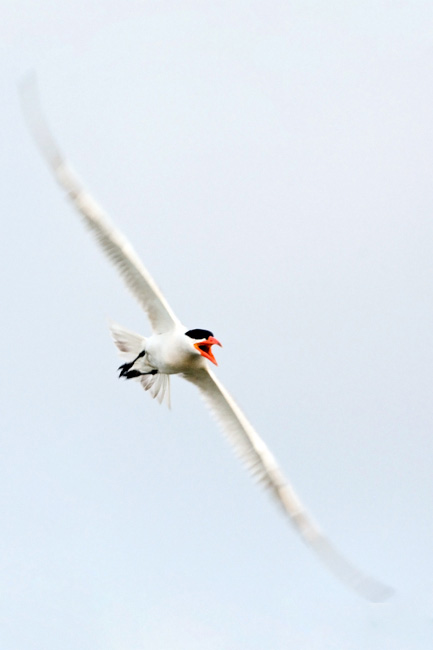
Caspian Tern in flight/early morning light¸ Tampa Bay, FL
Image Copyright 2007: James Shadle
Nikon 600mm F4 ED AF-S lens and the Nikon D2X. ISO 800. Matrix Metering against early white sky + 2 stops: 1/125 sec. at f/6.3 in Manual Mode
Yes, you can use ISO 800 with the Nikon D2X. This image was processed without any noise reduction in ACR 4.1
Shooting a high key image with the histogram to the right sure does help to keep the noise down. If you want maximum image quality and minimum noise you must nail the exposure (regardless of which camera system you are using).
ABP vs ABP II VS DB
We receive e-mails almost daily asking about the merits and the specifics of the original “The Art of Bird Photography; The Complete Guide to Professional Field Techniques (now in soft cover),” The Art of Bird Photography II (on CD only), and our Digital Basics File (a DPF sent via e-mail.) To clear up any confusion, consider the following:
Note: The soft cover version of “The Art of Bird Photography; The Complete Guide to Professional Field Techniques” has been dropped by Amphoto and is currently out of print. We have approximately 50 copies left. Because the book has been harder and harder to get, our sales have increased. We have purchased the film from Watson Gupthill and will be re-releasing the book with a new cover under the BIRDS AS ART imprint in about six months.
In January 2003, I began work on “The Art of Bird Photography II” (ABP II). “The Art of Bird Photography II is an all-new continuation of the original “The Art of Bird Photography; The Complete Guide to Professional Field Techniques.” At 916 pages with more than 900 images, ABP II is available only on CD. One chapter covers all aspects of Digital Photography and includes a section on understanding histograms. It also includes our complete digital workflow along with tons of great Photoshop tips. Other chapters include "Equipment; What's New?," "Advanced Composition and Image Design," "It Ain't Just Birds," and "Advanced Sharpness Techniques & Creating Pleasing Blurs." The "Practicalities" chapter will include a detailed section on setting up your backyard for bird photography as well as sections on photographing on safari and on the tundra. In addition it covers the every day aspects of handling and transporting your equipment from setting up your tripod to packing and traveling by air with your gear. Nearly all of the images in the book include all the technical data as well as our legendary educational captions. Most chapters include one or more galleries designed to illustrate and reinforce the principles covered in the text. There are two copies of the book on the CD. The "Spreads" version is best if you would like to enjoy the beauty of the images and the layout and design. The "Single Pages" version was designed for easy reading. The "Exposure and Flash Simplified" chapter re-visits two subjects that give folks the most trouble. Since the publication of ABP in 1998 we have refined and simplified our teaching in these two areas and these new approaches are covered in this all-new material. “Is the sun in or out? What is the overall tonality of the scene? When the sun is out at full strength your evaluative or matrix meter is smart. When it is cloudy, the same meter is dumb and needs your help. In addition to teaching this new approach to exposure the section on flash covers the use of fill flash, the use of flash as main light, and—for advanced students—the use of Manual Flash as main light. Other than the information in this chapter, virtually all of the material in ABP II is new.
ABP II, a professionally burned and manufactured CD version replete with a cardboard CD case and CD face art, was released in November, 2006. You can purchase a copy now for $40 plus $2 shipping and handling: http://www.birdsasart.com/ABPII.htm. Folks who purchased a pre-publication version of ABP II may purchase the final version for only $10 plus $2 shipping.
After beginning work on ABP II, I realized that the CD book would not be ready for quite some time but that the information on digital photography, Breezebrowser and Downloader Pro, and Photoshop was of great value to the legion of folks just getting started in digital photography, thus we began offering our Digital Basics file (DB) that includes free updates for as long as I am around pushing the shutter button. You can learn more about DB ($20 for the PDF that is delivered by e-mail here: http://www.birdsasart.com/digitalbasics.htm.
With more than 2,400 copies sold, Digital Basics has succeeded beyond our wildest dreams. On the other hand, it is surprising that we have not sold ten times as many. Why? First off, we have received nothing but positive feedback. DB was created so that folks with no digital experience can be optimizing their images exactly as I do within minutes; just print the section on digital workflow, open an image in Photoshop, and follow the script. It's that simple. My approach to Photoshop is a direct one: because I have so many images to process, my choice is to make the images look as good as possible in the shortest amount of time and DB teaches you to do just that. The thing that amazes me is that when we conduct our IPT Photoshop sessions, I find that most photographers, including many experienced ones, have no clue as to how to make their images look great in Photoshop, and do not understand how to use Photoshop to automate a variety of tasks. When I ask, "Do you have our Digital Basics File?" the answer is always, "No." It makes you think: these folks have spent huge sums of money on equipment and joined an IPT, yet they have not spent the additional $20 that would greatly improve the quality of their processed images and reduce the time that it takes for them to optimize an image. (Most of my family jewels are optimized in three to five minutes...)
The Digital Chapter in ABP II contains virtually the same information as in the April 2005 version of Digital Basics. The additional information (including the complete workflow for making conversions in Adobe Camera RAW) in the May 2006 update does not appear in ABP II. For this reason, we advise that serious digital photographers purchase both ABP II for the amazing wealth of information that it contains and DB so that they can receive the free DB updates that contain the latest and greatest Photoshop techniques that I have learned. The December 2006 update included all of the wonderful Photoshop tips that I learned from Alejandro Furman on the last Katmai bear boat trip including making and using color selections, darkening selected portions of an image, and removing color casts, and the next update will include info and comments on CS3.
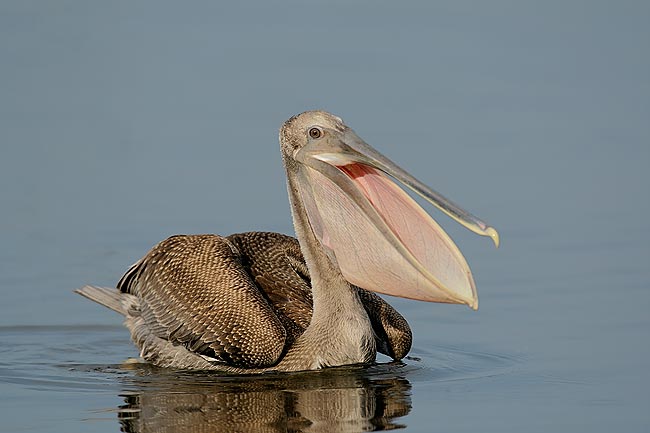
Brown Pelican, fresh juvenile swallowing tiny baitfish, Tampa Bay, FL with James Shadle
Image Copyright 2007: Arthur Morris/BIRDS AS ART
Canon EF 600mm f/4L lens with the EOS-1D Mark III. ISO 400. Evaluative metering +2/3 stop: 1/1250 sec. at f/5.6 in Manual mode.
The variety of subjects available right now on Froggie’s boat trips is simply astounding; the young pelicans in fresh plumage are both gorgeous and tame.
MORE MARK III TIPS & MIII UG COMMENTS
We e-mailed the MIII User’s Guide Update on Tuesday. If you have previously purchased the MIII UG and have not received your update yet, please e-mail us (and let us know how you paid) so that we can send you the update and add your name the distribution list.
In the update I wrote the following (updated text in blue):
In the C. Fn III group, C. Fn-III2 (AI Servo tracking sensitivity) is set to Slow. This makes it easier to keep tracking the subject as it keeps the active AF sensor from searching for the background should the sensor fall off the subject. It also keeps the system from tracking another subject that has entered the frame. Some folks are recommending that C. Fn. 2 should be set between Slow and the default setting, and some folks are suggesting that setting C.Fn. III-2 to Fast is the way to go. I will be trying various settings for this one and let folks know via Bulletin and MIII UG Updates if I find anything significant. If you get in a good flight photography situation it is advised that you do the same. (Late news: early results indicate that Fast may very well be best here…)
Here is some additional info on C.Fn. III-2. It would seem that setting C.Fn. III-2 either to Slow or to the setting between Slow and the default may prove to be best for most flight and action photography, but that if you are photographing birds or animals coming right at you at fairly high speeds then setting C.Fn. III-2 to High might be best.
The above is a sample of the detailed info that is included in the 12,825 word MIII UG. You can order your copy of the Mark III User’s Guide PDF (sent only via e-mail) right now for $20. As is usual, Paypal is quite convenient. Alternatively, you can call us at 863-692-0906 with credit card in hand or send a check for the correct amount made out to “Arthur Morris” to us as follows: Arthur Morris/BIRDS AS ART, PO Box 7245, 4041 Granada Drive, Indian Lake Estates, FL 33855.
Do note that all of Robert’s and all of my images in this Bulletin were created with the Canon EOS-1D Mark III; not bad for a camera with all that bad press…
Last note: it is my understanding that there will be a new firmware release for the MIII this week. Details to follow.
MIII UG Kudos via e-mail:
I just wanted to send you a note of thanks. The updated user guide for the MK III is invaluable. I'm off to Iceland with Daniel Bergmann next week and the updated guide has really helped me set up the camera for the trip. I really appreciate all the work that went into the guide to help others get the most from the camera. Thank you again. Jed Best
From Hunt’s Photo:
Gary has been working very hard to try and satisfy all of the BAA subscribers who are on the MIII waiting list in a timely fashion. With huge demand and relatively small shipments, he is doing his best to keep everyone happy by getting them cameras as quickly as possible. If you would like to get on the list, you can contact Gary as follows: by phone at 1-800-221-1830 ext 2332 or by e-mail me at digitalguygary@wbhunt.com.
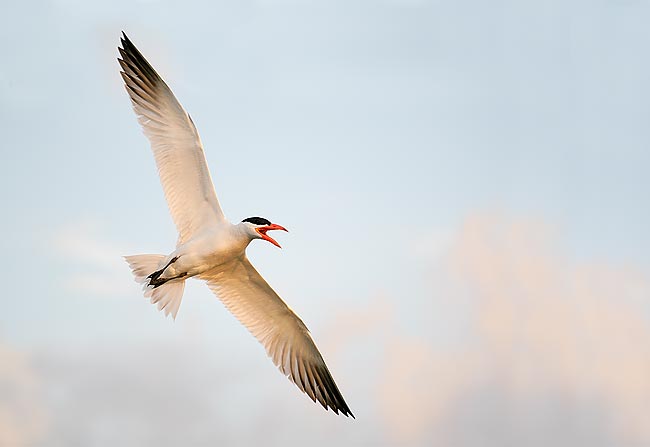
Caspian Tern screaming, Tampa Bay, FL with James Shadle
Image Copyright 2007: Arthur Morris/BIRDS AS ART
Canon EF 70-200mm f/4L IS lens (handheld at 200mm) with the EOS-1D Mark III. ISO 800. Evaluative metering + 1 2/3 stops: 1/1000 sec. at f/4 in Manual mode.
As we have been trying to drum into your heads for years, when the light levels are very low (as here—in early, early morning), the meter is dumb even when the sun is “out.” In order to avoid serious underexposure in these situations you need to add lots of light.
ROBERT O’TOOLE’S CORRUPTION PREVENTION AND IMAGE RESCUE TIP
Never attempt to use a damp or wet flash card. After years of trying I finally succeeded in corrupting a Sandisk compact flash card. I have gotten my Canon CF card case wet more times than I care to think about without encountering any ill effects. My Sandisk 4GB Extreme III card was damp after getting splashed or slightly submerged in saltwater…. I blew on the card and tapped it on my lens a few times. The pin holes looked dry so I installed the card into Artie's EOS-1DMKIII. The camera worked great for 40 minutes or so than locked up. The rear display read “card error install a new card.” I pulled the card out, tapped it again, and reinstalled it. This time the display read this card is not formatted, format now? I borrowed a dry card from James Shadle and all was well for the time being. Here is what the card looked like on my PC when I got home:

When I attempted to download the images, the card crashed Downloader Pro. Windows was able to look at the contents of the card without crashing. Then my rescue attempts went from bad to worse as trying to open a file would crash my PC. I installed a new HDD rescue program that I recently downloaded here: http://www.z-a-recovery.com/register.htm. It worked perfectly and I was able to rescue all of the files as TIFFs. Then I batch renamed all the file extensions using another program.
The rescue was a success and after the extraction and renaming both Photoshop
and Breezebrowser were able to read and open the CR2 files without any problems.
The HDD rescue program was also able to extract some files from the previous
day even though the card had been formatted in-camera that morning. This
is something important to note for anyone that has ever formatted a flash card
with new images that haven’t been downloaded. I will create an image rescue
tutorial with complete details and step-by-step instructions on exactly how I
rescued my files. It will be included in the August APTATS newsletter.
(Robert’s July APTATS newsletter was sent recently to the more than 500 folks
who signed up after seeing his June newsletter that was attached to the last BAA
Bulletin.) If you are not on my APTATS newsletter email list, you can sign up
typing APTATS Newsletter in the subject line and e-mailing me at
Robert@RobertOToolePhotography.com.
(Note from AM: I have washed my Delkin e-Film Pro Cards with my dirty laundry and had them sit for a day in a garbage bag replete with the day’s discarded grease from a Chinese restaurant without running into any problems at all…)
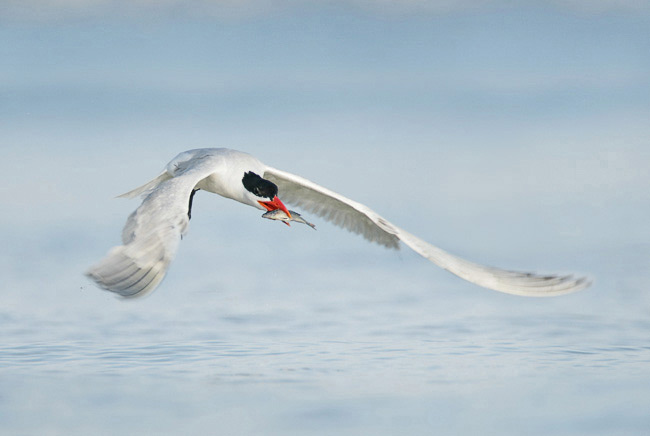
Caspian Tern water take off with baitfish (rescued image)
Image Copyright 2007: Robert O’Toole
Canon EF600mm f/4L USM lens with the 1.4X II TC and the EOS-1D Mark III. ISO 200. Evaluative metering +2/3 stop: 1/800 sec. at f/5.6 in Manual mode.
Of all the images that I was able to extract and save, this is my very favorite.
(Note: Robert was able to make a sharp image hereof a bird in flight with a background other than sky while using the Mark III and 45-point AFPS; this is something that I—and many others—have been unable to do only on rare occasion . Can you say “skill and superior technique”? ps: I love the wings in the down-stroke position.)
JUNE 2008 BEAR BOAT TRIP LED BY ROBERT O’TOOLE
June 4-10, 2008 (Limit 6/5 openings; this trip needs 4 to run.) Coastal Brown Bears, bears with cubs, bears clamming, bears courting, bears with foxes, foxes. Bald Eagle chicks in the nest (nearly guaranteed), Glaucous-winged Gull & Black-legged Kittiwake colonies, sea otters. Whales and endangered Steller’s Sea Lions possible. Scenics. Macro instruction; learn how Robert uses a spherical diffuser to create his incredible macro images. You can learn more about Robert here: www.robertotoole.com.
Important note: this trip will be led by Robert O’Toole. Experienced bear guide Chuck Keim will also be with you. (I will not be on this trip.)
Robert has been on the Bear Boat with Chuck. He is a Photoshop wiz and a superb Photoshop instructor. He figured out how to use Quick Masks to make your Photoshop sessions far more effective, efficient, and rewarding. He is the author of APTATS PDF. Robert is talented and extremely creative. I learn from him often. His vertical image of a Bald Eagle in flight was honored in the 2006 BBC Wildlife Photographer of the Year Competition (and I guarantee you that it will not be his last…) He has co-led more BAA IPTs than anyone but me <smile> There will be lots of time for Photoshop lessons and image-sharing around the galley table for those who wish to indulge. (There is electricity on the boat.) I wish I were going!
Five full and two half-days of photography (weather permitting). Halibut fishing optional. Fish can be shipped home from Kodiak.
Fly to Kodiak from Anchorage on the early morning of June 4. Pick-up by van and travel to Anton Larsen Bay to be picked up by skiff for transfer to the Coastal Explorer. Weather permitting: photograph the sea otters that afternoon. Cross the Shelikof Strait that afternoon/evening. If it is too windy to cross, will stay the night in Kodiak (anchored), do more of the Sea Otters, and then cross when feasible. (It rarely blows for more than 24 hours but we will be in Alaska…)
Once across the strait, it will be bears and birds. We should see lots of big boars in Hallo Bay and have some good chances to photograph bears clamming at close range. Courtship, copulation, spring cubs, bears feeding on grasses, and Arctic Fox are all likely possibilities. Bald Eagle chicks will be in the same nest nearly every year. (Chuck has several back-up nests.) On the same island as the usually-occupied eagle nests there should be nesting Black Oystercatchers and Glaucous-winged Gulls. Photograph a Black-legged Kittiwake colony from the boat at fairly close range. There will be lots of opps for flight photography.
Registrants MUST be in Anchorage by the afternoon of June 3, but it is highly recommended that you arrive on June 2nd so that you do not risk missing the boat due to a flight delay. (There will be some good stuff around Anchorage to photograph: nesting Mew Gulls and Red-necked Grebes are likely…) If you do come on the 2nd, that hotel room is on you.
Dinner in Anchorage and intro slide program early evening June 3rd.
$5999 includes flights to and from Kodiak, return float plane flight to Kodiak from the boat, a shared hotel room on the night of June 3rd (single supplement: $85 if available), van transport on Kodiak, shared (small) stateroom, and all meals on the boat. If Erik is back again, I can guarantee absolutely amazing food… If not, then just great food. Not included: your flight to and from Anchorage and the tip: $200 total per person tip recommended.
If you would like to join Robert for the experience of a lifetime, please let us know immediately via e-mail that you will be sending a deposit as I expect this trip to fill quickly. If there is anyone on the sold-out September trip who would like to switch to this trip, please e-mail me immediately. (The September trip has a long waiting list.)
Deposit: $1000. (Non-refundable unless the tour fills with 6.)
1st installment: $2500 due Oct. 4, 2007.
Final payment: $2499 due Feb. 4, 2008
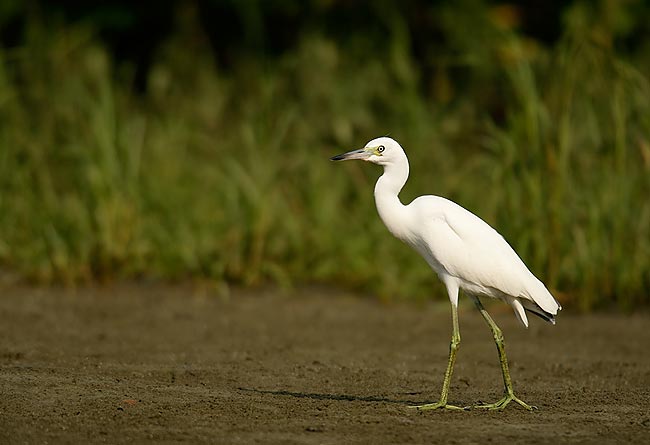
Little Blue Heron, juvenile on mud flat, Tampa Bay, FL with James Shadle
Image Copyright 2007: Arthur Morris/BIRDS AS ART
Canon EF 600mm f/4L lens with the 1.4X II TC and the EOS-1D Mark III. ISO 400. Evaluative metering at zero: 1/2000 sec. at f/5.6.
I used the manually selected sensor to the right of center to create this image.
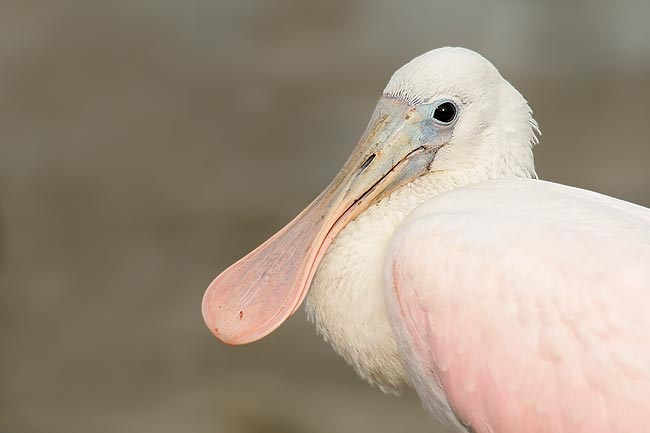
Roseate Spoonbill in fresh juvenal plumage on mud flat, Tampa Bay, FL with James Shadle
Image Copyright 2007: Arthur Morris/BIRDS AS ART
Canon EF 600mm f/4L lens with the 2X II TC and the EOS-1D Mark III. ISO 400. Evaluative metering +2/3 stop: 1/400 sec. at f/10.
The soft light on our Thursday afternoon trip was a blessing.
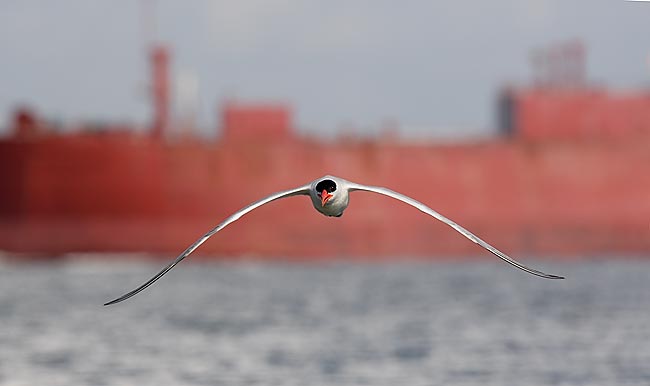
Caspian Tern and cargo ship, Tampa Bay, FL with James Shadle
Image Copyright 2007: Arthur Morris/BIRDS AS ART
Canon EF 600mm f/4L lens with the 2X II TC and the EOS-1D Mark III. ISO 400. Evaluative metering +2/3 stop: 1/400 sec. at f/10.
Here,45-point AAFPS performed perfectly. Reports that the MIII is unable to hold focus on birds in flight especially with backgrounds other than sky) would appear to have been greatly exaggerated (possibly fanned by the flames of internet hysteria).
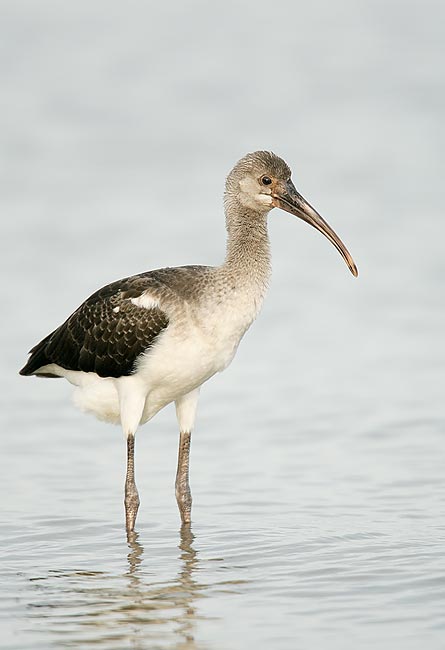
White Ibis, fresh juvenile, Tampa Bay, FL with James Shadle
Image Copyright 2007: Arthur Morris/BIRDS AS ART
Canon EF 600mm f/4L lens with the 1.4X II TC and the EOS-1D Mark III. ISO 640. Evaluative metering +1 1/3 stops: 1/800 sec. at f/5.6.
This bird may have been hatched less than 100 yards from where it fed in the shallows. Using the techniques outlined in Digital Basics (http://www.birdsasart.com/digitalbasics.htm) this image was optimized in less than two minutes in Photoshop CS3.
Laughing Gull atop fresh juvenile Brown Pelican, Tampa Bay, FL with James Shadle
Image Copyright 2007: Arthur Morris/BIRDS AS ART
Canon EF 600mm f/4L lens with the EOS-1D Mark III. ISO 400. Evaluative metering +2/3 stop: 1/1250 sec. at f/5.6 in Manual mode.
The Laughing Gulls often land on the pelican’s backs or heads in an attempt to scavenge the baitfish that escape from the pelican’s bill pouch as it squishes out the water. In the full resolution TIFF it is easy to see that the gull’s feet are nestled down about 2-3 inches in the bird’s soft feathering.
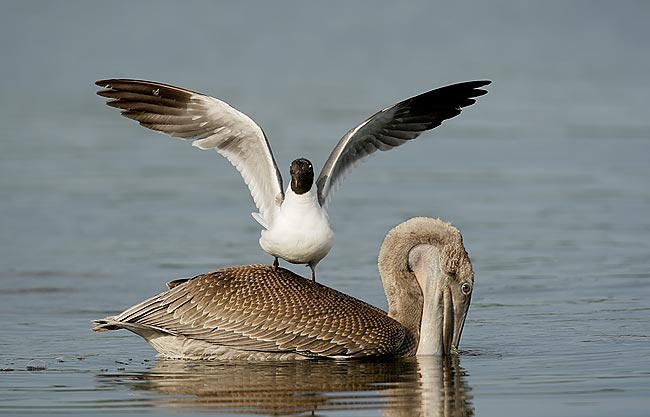
Caspian Tern, large chick begging, Tampa Bay, FL with James Shadle
Image Copyright 2007: Arthur Morris/BIRDS AS ART
Canon 600mm f/4L IS lens with the 1.4X II TC and the EOS-1D Mark III. ISO 400. Evaluative metering +2/3 stop: 1/800 sec. at f/13 in Manual mode.
Even in bright sun it may be necessary to add some light after checking the histogram; remember: you always want at least some data in the fifth box!
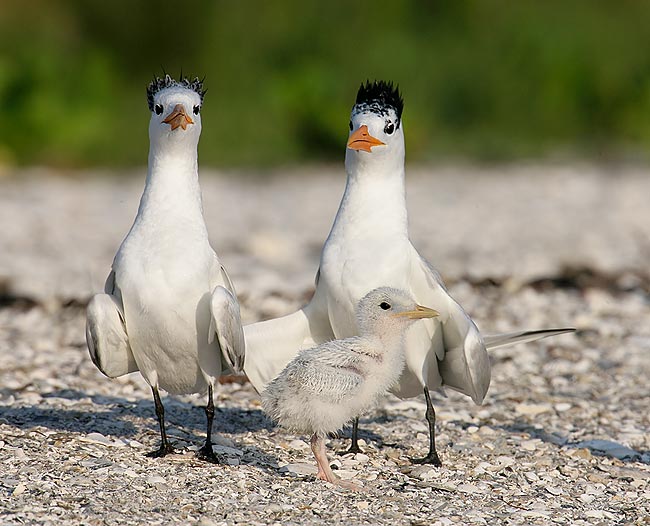
Royal Tern family, Tampa Bay, FL with James Shadle
Image Copyright 2007: Arthur Morris/BIRDS AS ART
Canon 600mm f/4L IS lens with the 2X II TC and the EOS-1D Mark III. ISO 250. Evaluative metering +1/3 stop: 1/320 sec. at f/14.
I went with lots of extra depth-of-field here in an effort to sharply render all the birds in the portrait. In bright sun, images from the MIII are without compare…
Best and love and great picture-making to all,
artie
Note: Arthur Morris has been a Canon contract photographer since 1994 and continues in that role today. Hunt's Photo of Boston, MA is a BAA sponsor as it Delkin Devices. Back issues of all BAA Bulletins can be found in the Bulletin Archives